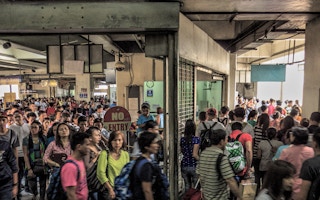On any given working day, whether you are driving around Manila, Jakarta, or Bangkok, the experience tends to be the same—long spells crawling in slow-moving or almost stationary traffic. The personal time and wider economic wastage from these lost hours stuck in traffic have been quantified by various researchers. As a recent blog by a colleague stated, in Metro Manila, where ADB is headquartered, you could spend 1,000 hours a year in traffic.
There are many reasons for the situation but overriding is that transport infrastructure has simply not kept pace with the relatively rapid city growth in the last 40 years, where road networks have traditionally been at the core of modern public infrastructure investment.
Although all three mentioned megacities have achieved middle-income status, this happened too late for the phasing-in of mass rapid transit that meets real-time carrying capacity demands given urban population growth trajectories. These cities are enjoying rising real incomes but at the cost of living conditions, which are subject to increasing congestion levels and limited accessibility.
In its landmark report on Meeting Asia’s Infrastructure Needs in 2017, ADB highlighted the need for $1.7 trillion annually to pay for developing Asia’s infrastructure from 2016 to 2030. There is a large difference between this target and current levels of spending. And the biggest infrastructure finance gap is in the transport sector, where $600 billion is needed annually across developing Asia. Further, almost 80 per cent of transport infrastructure financing in developing Asia comes from the public sector, which has many other priority spending needs.
“
Successful, developed cities such as Tokyo, Osaka, Nagoya, Singapore and Seoul have all previously made the transition from developing city status into the top league of economic performance, all with a strong focus on mass rapid transit investment that rested on value capture concepts.
Other funding sources are clearly needed to bridge the infrastructure gap. One innovative option is land value capture (LVC). Through this, improved accessibility garnered from infrastructure such as metro lines triggers rises in land values. The concept of LVC is that those who benefit from transit’s added value should contribute to the cost of high-quality transit connections.
A new ADB report, Sustaining Transit Investment in Asia’s Cities, highlights the potential for land value capture in the context of Bangkok, Jakarta, and Manila. The report systematically reviews 61 mass rapid transit systems in advanced and developing economies and provides case studies of changes in land prices around mass rapid transit stations in Bangkok, Jakarta, and Manila. It shows that there are significant price premiums for properties near a mass transit station; the closer you get to a station, the more expensive land becomes—particularly for commercial properties.
For example, in Manila, land value uplift in the catchment area of MRT-3 metro stations amounts to an estimated $3.5 billion—five times the building cost of MRT-3.
When the public sector properly secures the windfalls from increased revenues resulting from its own infrastructure investments, the burden on traditional sources of tax is reduced. Recycling LVC revenues back into mass rapid transit allows cities to continually expand their transport networks, rather than worrying how each new addition will be funded.
But what’s in it for the private developers and landholders? The answer is they benefit from participation in LVC because they gain more in value added to their property from improved accessibility than the contribution asked of them.
Despite the potential for LVC in rapidly growing and urbanising Asia, many cities still lack the conditions required for successful LVC implementation. As the new report points out, LVC can be achieved in several ways—strengthening the legal, regulatory, and institutional frameworks; learning from successful models elsewhere, and developing institutional capacity.
Successful, developed cities such as Tokyo, Osaka, Nagoya, Singapore and Seoul have all previously made the transition from developing city status into the top league of economic performance, all with a strong focus on mass rapid transit investment that rested on value capture concepts.
The report recommends five mechanisms to pursue LVC, each intended to be complementary and mutually supportive.
Mainstream tax system—this is one of the most important points. Improving land valuation to increase property-related tax revenues close to transit stations is core to sustaining investment and growth in mass rapid transit.
Special fees and levies—these target specifically defined beneficiaries, for example, those benefiting from a major transit upgrade. It can also take the shape of charging connection fees to property owners for physically integrating their property to a transit station.
Auction of development rights—this involves putting a development opportunity associated with a new transit facility or line up for sale, via open auction.
Urban renewal agency with value capture capabilities—a comprehensive authority would work to generate new property value, work with access enhancements and delivery of needed transit infrastructure to generate value capture.
Rail agency as developer—this involves a transit operator developing and trading property associated with stations and their precincts on a commercial basis. Some of the profit from these activities would be channeled to transit infrastructure. This model is widely used in East Asian cities, including Japan and Singapore.
Sustaining Transit Investment in Asia’s Cities is especially timely. In an effort to bridge the infrastructure gap in developing Asia, ADB is financing mass rapid transit in Bangkok, Bengaluru, Hanoi, Ho Chi Minh City, Jaipur, Mumbai, and Tbilisi.
ADB is also helping to improve the ability of governments to capture some of the land value they have created through transit investment. Technical assistance—including efforts to support the Philippine government to reform property taxation and value assessment—will strengthen domestic resource mobilization across the region.
Both the Sustainable Development Goals and ADB’s own Strategy 2030 emphasize sustainable urban development, which can be promoted through effective public sector reforms, private sector development, and domestic resource mobilisation. The report, therefore, serves as a springboard for discussion on how proven methods of LVC can be applied in developing Asia to promote Strategy 2030 goals.
Adopting LVC in cities like Bangkok, Jakarta, and Manila creates a triple win.
The first win is that it helps finance metro systems and thus improve overall urban mobility.
The second win is that if used properly, LVC reduces the subsidy levels required in running metro systems, since the money from LVC can also go toward operating costs.
For the third win, the money generated from LVC creates the fiscal space to use government finance productively for other sectors—such as health, education, and slum improvement.
Taking action on this issue will not only pave the way for viable mass rapid transit systems but spur a new period of sustained growth, improved living conditions, and—of course—less clogged roads.
Bambang Susantono is Vice President for Knowledge Management and Sustainable Development at the Asian Development Bank.
This blog was first published as an opinion article in The Nation and in The Jakarta Post.











